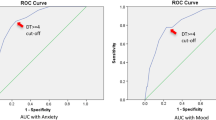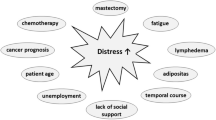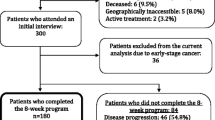Abstract
Goals of work
Distress in cancer patients is common. In the last years, several studies have used the single-item Distress Thermometer (DT) as a screening tool for psychological distress in cancer patients. The primary objective of this study was to determine the optimal cutoff score on the DT for detecting psychological distress in cancer patients attending a rehabilitation center, by comparing the DT’s scores with those of the Psychological Distress Inventory (PDI). The second aim was to explore the effectiveness of the DT as a screening tool for psychological distress in rehabilitative oncological setting.
Patients and methods
The sample study totaled 290 patients who were recruited from patients attending the Oncological Rehabilitation Center of Florence for the first time between January and December 2007. Patients were administered the DT along with the Problem List (PL) and the PDI as the gold standard against which the DT was compared.
Main results
The area under the receiver operating characteristics curve was 0.84 [95%CI 0.80–0.89]. The optimal DT cutoff score for identifying distressed cancer patients would be at or above 7 (sensitivity = 0.73; specificity = 0.82). Patients whose DT score was 7 or above were more likely to report problems in all issues on the PL.
Conclusions
The combination of DT and PL could be a practicable screening instrument for assessing the extent and the kind of distress also in rehabilitative oncological patients. On the other hand, the choice of the DT should be evaluated by clinicians.


Similar content being viewed by others
References
Akizuki N, Akechi T, Nakanishi T, Yoshikawa E, Okamura M, Nakano T et al (2003) Development of a brief screening interview for adjustment disorders and major depression in patients with cancer. Cancer 97:2605–2613. doi:10.1002/cncr.11358
Akizuki N, Yamawaki S, Akechi T, Nakano T, Uchitomi Y (2005) Development of an impact thermometer for use in combination with the distress thermometer as a brief screening tool for adjustment disorders and/or major depression in cancer patients. J Pain Symptom Manage 29(1):91–99. doi:10.1016/j.jpainsymman.2004.04.016
American Psychiatric Association (1994) Diagnostic and statistical manual of mental disorders: DSM-IV, 4th edn. American Psychiatric Association, Washington, DC
Bultz BD, Psych C, Holland JC (2006) Emotional distress in patients with cancer: the sixth vital sign. Psychosoc Oncol 3:311–314
Carlson LE, Angen M, Cullum J et al (2004) High levels of untreated of distress an fatigue in cancer patients. Br J Cancer 90:2297–2304
Chochinov HM, Wilson KG, Enns M et al (1995) Desire for death in the terminally ill. Am J Psychiatry 152:1185–1191
Derogatis LR (1983) The prevalence of psychiatric disorders among cancer patients. JAMA 249:751–757. doi:10.1001/jama.249.6.751
Derogatis LR (2000) Brief symptom inventory 18: administration, scoring and procedures manual. National Computers Systems, Minneapolis
Fallowfield L, Ratcliffe D, Jenkins V, Saul J (2001) Psychiatric morbidity and its recognition by doctors in patients with cancer. Br J Cancer 84:1011–1015. doi:10.1054/bjoc.2001.1724
Fang CY, Manne SL, Pape SJ (2001) Functional impairment, marital quality, and patient psychological distress as predictors of psychological distress among cancer patients’ spouses. Health Psychol 20:452–457. doi:10.1037/0278-6133.20.6.452
Fisch M (2004) Treatment of depression in cancer. J Natl Cancer Inst Monogr 32:105–111. doi:10.1093/jncimonographs/lgh011
Gessler S, Low J, Daniells E, Williams R et al (2008) Screening for distress in cancer patients: is the distress thermometer a valid measure in the UK and does it measure change over time? A prospective validation study. Psychooncology 17:538–547. doi:10.1002/pon.1273, Published online in Wiley InterScience (www.interscience.wiley.com)
Gil F, Grassi L, Travado L, Tomamichel M, Gonzales JR (2005) Use of distress and depression thermometer to measure psychosocial morbidity among southern European cancer patients. Support Care Cancer 13:600–606. doi:10.1007/s00520-005-0780-0
Grassi L, Indelli M, Marzola M et al (1996) Depressive symptoms and quality of life in home-care assisted cancer patients. J Pain Symptom Manage 12:300–307. doi:10.1016/S0885-3924(96)00181-9
Graves KD, Arnold SM, Love CL, Kirsh KL, Moore PG, Passik SD (2007) Distress screening in a multidisciplinary lung cancer clinic: prevalence and predictors of clinically significant distress. Lung Cancer 55(2):215–224. doi:10.1016/j.lungcan.2006.10.001
Holland J (2003) Psychological care of patients. Psycho-oncology’s contributions. J Clin Oncol 21:253s–265s. doi:10.1200/JCO.2003.09.133
Hormes JM, Lytle LA, Gross CR, Ahmed RL, Troxel AB, Schmitz KH (2008) The body image and relationship scale: development and validation of a measure of body image in female breast cancer survivors. J Clin Oncol 26(8):1269–1274. doi:10.1200/JCO.2007.14.2661
Jacobsen PB, Moffitt HL (2007) Screening for psychological distress in cancer patients: challenges and opportunities. J Clin Oncol 25:4526–4527. doi:10.1200/JCO.2007.13.1367
Jacobsen PB, Donovan KA, Trask PC et al (2005) Screening for psychologic distress in ambulatory cancer patients. Cancer 103:1494–1502. doi:10.1002/cncr.20940
Keir ST, Calhoun-Eagan RD, Swartz JJ, Saleh OA, Friedman HS (2007) Screening for distress in patients with brain cancer using the NCCN’s rapid screening measure. Psychooncology 17:621–625 Published online in Wiley InterScience (www.interscience.wiley.com). doi:10.1002/pon.1271
Landis JR, Koch GG (1977) The measurement of observer agreement for categorical data. Biometrics 33:159–174. doi:10.2307/2529310
McDonald MV, Passik SD, Dugan W et al (1999) Nurses’ recognition of depression in their patients with cancer. Oncol Nurs Forum 26:593–599
Mitchell AJ, Kaar S, Coggan C, Herdman J (2007) Acceptability of common screening methods used to detect distress and related mood disorders—preferences of cancer specialists and non-specialists. Psychooncology 17:226–236 Published online in Wiley InterScience (www.interscience.wiley.com). doi:10.1002/pon.1228
Morasso G, Costantini M, Baracco G, Borreani C, Capelli M (1996) Assessing psychological distress in cancer patients: validation of a self-administered questionnaire. Oncology 53:295–302
National Comprehensive Cancer Network (2003) Distress management clinical practice guidelines. J Natl Compr Canc Netw 1:344–374
Newell SA, Sanson-Fisher RW, Savolainen NJ (2002) Systematic review of psychological therapies for cancer patients: overview and recommendations for future research. J Natl Cancer Inst 94:558–584
Ozalp E, Cankurtaran ES, Soygür H, Geyik PÖ, Jacobsen PB (2007) Screening for psychological distress in Turkish cancer patients. Psychooncology 16:304–311. doi:10.1002/pon.1059
Passik SD, Dugan W, McDonald MV et al (1998) Oncologists’ recognition of depression in their patients with cancer. J Clin Oncol 16:1594–1600
Patrick-Miller LJ, Broccoli TL, Much JK et al (2004) Validation of the distress thermometer. A single item screen to detect clinically significant psychological distress in ambulatory oncology patients. J Clin Oncol 24:525s (suppl; abstr 6024)
Quintard B, Lakdja F (2008) Assessing the effect of beauty treatments on psychological distress, body image, and coping: a longitudinal study of patients undergoing surgical procedures for breast cancer. Psychooncology 17:1032–1038 Published online in Wiley InterScience (www.interscience.wiley.com). doi:10.1002/pon.1321
Ransom S, Jacobsen PB, Booth-Jones M (2006) Validation of the distress thermometer with bone marrow transplant patients. Psychooncology 15:604–612. doi:10.1002/pon.993
Roth AJ, Kornblith AB, Batel-Copel L, Peabody E, Scher HI, Holland JC (1998) Rapid screening for psychologic distress in men with prostate carcinoma: a pilot study. Cancer 82:1904–1908. doi:10.1002/(SICI)1097-0142(19980515)82:10<1904::AID-CNCR13>3.0.CO;2-X
Shim EJ, Mehnert A, Koyama A et al (2006) Health-related quality of life in breast cancer: cross-cultural survey of German, Japanese, and South Korean patients. Breast Cancer Res Treat 99:341–350. doi:10.1007/s10549-006-9216-x
Sollner W, DeVries A, Steixner E et al (2001) How successful are oncologists in identifying patient distress, perceived social support, and need for psychosocial counselling? Br J Cancer 84:179–185. doi:10.1054/bjoc.2000.1545
Spiegel D, Saud S, Koopman C (1994) Pain and depression in patients with cancer. Cancer 74:2570–2578. doi:10.1002/1097-0142(19941101)74:9<2570::AID-CNCR2820740927>3.0.CO;2-3
StataCorp (2001) Stata statistical software: release 9.1. Stata Corporation, College Station
Valente SM, Saunders JM, Cohen MZ (1994) Evaluating depression among patients with cancer. Cancer Pract 2:65–71
Von Essen L, Larsson G, Oberg K, Sjoden PO (2002) Satisfaction with care: associations with health-related quality of life and psychosocial function among Swedish patients with endocrine gastrointestinal tumors. Eur J Cancer Care (Engl) 11:91–99. doi:10.1046/j.1365-2354.2002.00293.x
Zabora J, BrintzenhofeSzoc K, Curbow B, Hooker C, Piantadosi S (2001) The prevalence of psychological distress by cancer site. Psychooncology 10:19–28. doi:10.1002/1099-1611(200101/02)10:1<19::AID-PON501>3.0.CO;2-6
Zigmond AS, Snaith RP (1983) The Hospital Anxiety and Depression Scale. Acta Psychiatr Scand 67:361–370. doi:10.1111/j.1600-0447.1983.tb09716.x
Acknowledgement
Authors thank the volunteers of the “Donna Come Prima” Association (Italian League Against Cancer) for their precious help in collecting the questionnaires.
Author information
Authors and Affiliations
Corresponding author
Rights and permissions
About this article
Cite this article
Bulli, F., Miccinesi, G., Maruelli, A. et al. The measure of psychological distress in cancer patients: the use of Distress Thermometer in the Oncological Rehabilitation Center of Florence. Support Care Cancer 17, 771–779 (2009). https://doi.org/10.1007/s00520-008-0543-9
Received:
Accepted:
Published:
Issue Date:
DOI: https://doi.org/10.1007/s00520-008-0543-9




